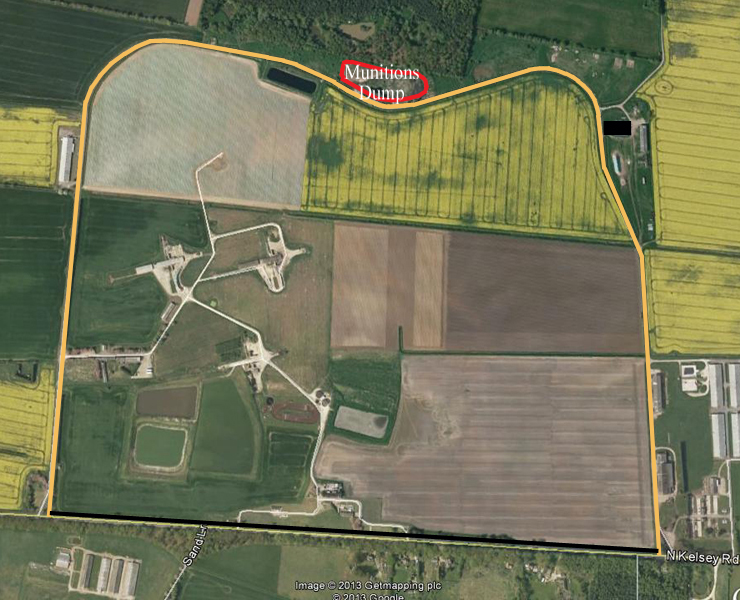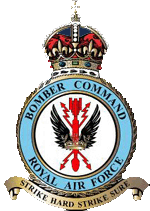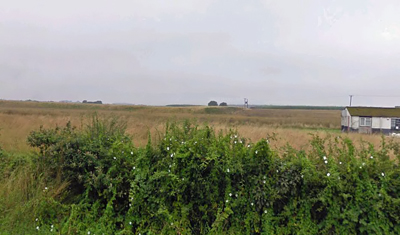Caistor Airfield History

(Map edited to show the airfield 1940-45)

© Crown Copyright/MOD 2010
53°30'15.33"N 0°21'37.05"WRunways:
Not known
RAF Caistor was a grass-surfaced airfield and served it's time during the war as a Relief Landing Ground (RLG) for a number of stations in the area. It had four grass landing strips of varying lengths, they ranged between 1100 yards to 1450 yards. The airfield opened on the 6th September 1940.
After the airfield was officially opened it was immediately used as a satellite of RAF Kirton-in-Lindsey, under the control of 12 Group, Fighter Command. Within only a few days, the station was to receive its first residents, in the form of ‘A’ Flight, No.264 Squadron on the 12th September. With the arrival of the squadron, came the first aircraft to the station, the Boulton Paul Defiants. The day after their arrival, No.264 Sqdn were pressed in to action, but under the strict orders of only operating at night. But their stay at the airfield was short lived, and on the 23rd October 1940, they left the airfield. October 1940 also saw the short visit of ‘A’ Flight, No.85 Squadron for daylight training. But after only a few short weeks, they left the airfield taking with them their Hawker Hurricane aircraft.
All was quiet at the station until the 15th May 1942, when control of the airfield was transferred to 15(P) AFU (Advanced Flying Unit) at nearby RAF Kirmington. But their control of the airfield was not to last long and the airfield was placed on Care and Maintenance until being transferred again, this time under the control of RAF Manby on the 9th December 1942. Despite the change of control, the airfield remained in a dormant state.
Activity at the airfield increased with the visit of staff members from the SFTS (Service Flying Training School) at RAF Cranwell on the 31st March 1943. The purpose of the visit was to assess the airfield with a view to use for night flying. An agreement was reached the following day, and the airfield was loaned Cranwell for their use. Shortly after, the first aircraft arrived at the airfield in the shape of the Airspeed Oxfords on the 6th April 1943.
The normal routine was for aircraft to arrive in the early evening and operate from the airfield during the night, and then they would return to Cranwell in the morning. A variety of aircraft operated from the station for night flying, but none remained there during the day. But this was to change after a few weeks, and a full flight was detached from the SFTS to the airfield bringing with them their Airspeed Oxfords and Miles Masters.
By September 1943, there was growing concern for the safety of the aircraft flying at night. This was due to the location of the airfield being so close to the coast and in turn the increased risk of attack by enemy aircraft. It was also believed that this was the cause behind the loss of a Master II (W9017) on the 4th September 1943. With this mind, the decision was taken to stop night flying from the airfield by mid-September 1943 and only day flying was permitted.
November 1943 was to see the arrival of some foreign visitors to the airfield in the form of personnel from the 346th Company, US Engineering Corps, and on the 4th December 1943 the ‘Stars and Stripes’ were raised for the first time at the station. The 364th personnel stayed at Caistor until the 4th February 1944, and were replaced with personnel from 948th Ordnance Corps on the 11th March. During the same month, the RAF Collage SFTS at Cranwell had been renumbered to 17 SFTS, and by September they had detached a flight of North American Harvards to the airfield.
But the all activity at the station was soon to be a thing of the past, with American’s leaving and 17 SFTS being moved to Coleby Grange, and by 16th November 1944 all was quiet again. With all the personnel gone form the station it was placed back on Care and Maintenance, and became the new home of 5354 Airfield Construction Wing. With this change of role, the control of the airfield was transferred to 43 (Maintenance) Wing on the 21st February 1945.
By the end of the war, the airfield was to change hands yet again, and transferred to the Ministry of Agriculture for allocation to the local farmers.
Over the coming years the airfield was slowly dispersed amongst the local farmers, and the land was returned to its former use. But in 1958 part of the former airfield was return to the Air Ministry. The reason behind the change was due to the onset of the Cold War, and the need for missile bases to house the newly developed Douglas Thor missile. Construction started immediately on three launch pads for the missile, and on the 22nd July 1959, No.269 Sqdn reformed at the station as part of the Hemswell Missile Wing. The HMW operated under the control of 1 Group, Bomber Command until the Thor missiles were withdrawn from the airfield in 1963. With the missile being withdrawn from the airfield No.269 Sqdn were disbanded 24th May 1963.
With the demise of the Thor missile and subsequently the airfield itself, it was slowly sold-off during 1964-65.

© BCAR - Looking towards one of the Thor Missile pads - 2010
The former airfield began its civilian life as a major production unit for Cherry Valley Farms. The company built a number of rearing houses within the old perimeter of the Thor site, and still reside at the same location to this day.
Of the three Thor missile launch pads built, not much remains. The blast walls along with at least one of the fuels pits still remain fully intact. Some of the shelter rails remain also, but none of the launch erector or short-range theodolite mountings or theodolite sheds have sadly survived.
A single blister remains to the north-east, although it has been re-cladded. A solitary Stanton shelter remains also on one of the former dispersed sites but the rest have sadly long since gone, with much of the area now taken over by a large caravan park and is now unrecognisable.
| Date | Squadron | Notes |
|---|---|---|
| September 1940 | Station opened as a relief landing strip for RAF Kirton in Lindsey. | |
| September 1940 | No.264 Sqn ('A' Flight) | Operating the Boulton Paul Defiant. The squadron left Caistor on 23rd October 1940. |
| October 1940 | No.85 Sqn ('A' Flight) | Operating the Hawker Hurricane. Left the airfield a few weeks later in the same month. |
| May 1942 | No.15 (P) AFU | Operating the Airspeed Oxford. Left the station on 8th December 1942. |
| April 1943 | RAF Collage SFTS | Operating the Airspeed Oxford and Miles Master. The Service Flying Training School was renumbered to 17 SFTS on 20th March 1944. |
| November 1943 | 346th Company US Engineering Corps | Left the airfield on 4th February 1944 |
| March 1944 | 948th Ordinance Corps | Left the station in November 1944. |
| November 1944 | Station placed on Care and Maintenance. | |
| November 1944 | 5354 Airfield Construction Wing | Left Caistor in September 1945. |
| September 1945 | Station closed. | |
| 1958 | Station re-opened | |
| July 1959 | No.269 (SM) Sqn | Operating as a Thor Missile Unit. The squadron disbanded on the 24th May 1963. |
| June 1963 | RAF Caistor closed for the final time. | |
| 1964-65 | Station sold-off. |
